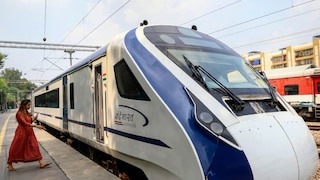Written By: Akhileshwar Sahay
News18.com
Last Updated: March 27, 2024, 15:30 IST
New Delhi, India
Indubitably, the emergence and mainstreaming of the fully indigenous semi-high-speed Vande Bharat trains has been the singular achievement of the Modi government in the past ten years. (File photo)
Before the announcement of the schedule of the general elections by the Election Commission, Prime Minister Narendra Modi in the first 75 days of the year 2024, dedicated to the nation completed infrastructure projects worth more than Rs 11 lakh crore across sectors, including more than one lakh crore projects related to Indian Railways. He also said that the last ten years gone by are trailers and the next ten years will be transformative for Indian Railways.
As Prime Minister Modi seeks an unprecedented third term in office, the time is ripe to make a threadbare impartial analysis of the performance of his government in the last ten years. In Part 1 of this multi-part series, I begin with the hits and misses of 10 years of Prime Minister Narendra Modi in the arena of the Indian Railways. And I begin with a humble submission – when it comes to Indian Railways, the performance, though laudable, leaves many boxes unticked.
The above is a laudable achievement notwithstanding the fact that the actual performance falls short of what was promised – 75 operational Vande Bharat trains in the 75th year of the independence. However, there is an unfinished agenda. So far, Vande Bharat trains, despite having a designed speed of more than 160 kmph, are running at the suboptimal speed of 100 kmph or less, due to operational limitations related to line capacity, signalling and track infrastructure deficiency. This anomaly needs to be fixed at the war footing.
The first project of 82 km Namo Bharat between Delhi and Merrut (34 km 8 stations already operational) will transform the regional rail connectivity in the same way metro rails are today transforming intra-city mobility. When the entire 82 km is completed by June 2025, it will alter the very pattern of urbanisation of India and once the planned Namo Bharat connectivity projects connecting Delhi with regional cities in UP, Haryana and Rajasthan are completed, it will have a cascading effect of having more such regional connectivity projects connecting other Indian metropolises with nearby cities in the hub and spoke model.
Also, Prime Minister Modi succeeded partially where others failed. He learnt the basic lesson that the way to modernise stations is largely through public finances and he has met with half a dozen initial success stories – Bhopal Rani Kamlapati Station, Gandhi Nagar, Sir Visvesvaraya Terminal Bengaluru, Gomti Nagar Lucknow and most importantly, Ayodhya Dham. The real challenge before Modi 3.0 or whoever forms the next government is to mainstream the station modernisation program and ensure its success after many false starts.
It is worth noting here that between 2014 and 2022, a total of 893.82 km of track has been converted to broad gauge, 386.84 km of new lines added, 356.41 km of double lines commissioned, and a survey of 1578 km of new lines were completed. The railway network already connects the state capitals of Assam, Tripura and Arunachal Pradesh with broad gauge lines and IR is working to connect all the state capitals. Also, the government gets the credit for fast-tracking the full completion of the delayed Kashmir rail link project.
Railway electrification is one area where it is all kudos to the Modi government. Between 2014-2024, Indian Railways electrified a record 40318 Route Kilometres (RKM) as against 5047 RKM in 2005-2014. As on March 1, 2024, the electrified network of the Indian Railways stands at 62,119 RKM which is about 94 per cent of the total broad gauze RKMs i.e. 65775 RKM, making it the greenest railway network in the world. While electrification per se is laudable, there is a strong case for fast greening of the source of electricity that IR consumes.
In the past ten years, 1337 km of eastern DFC and 1046 km of western DFC have been made operational. Never in the past since independence, a railway project of such magnitude and complexity was completed in such a time frame. This is the nation’s first achievement. However, for the full benefit of the DFC to accrue to the nation, a stuck portion of the eastern DFC (538 km between Sone Nagar and Dankuni) and under construction 460 km of western DFC need to be completed quickly without any further delay, more so because the project cost owing to the time and cost overrun has increased from Rs 50,000 crore to Rs 1,25,000 crore.
While the above achievements are laudable, as the progress of the railroad in China shows, there is a need for a much faster increase of rail infrastructure in the country. And the truth beckons, Indian Railways remains a work in progress with many unticked boxes and an unfinished agenda. More important are as under-
Much has been done to make the elephant known as the Indian Railways to dance. But all is not well. A lot more needs to be done to first make the IR stay an ongoing concern and then contribute its might to the nation. It is time to rethink, reimagine and reboot the Indian Railways. That remains the unfinished agenda for the next government, and it is neutral to whether it will be Modi 3.0 or some other dispensation.
The author is Multidisciplinary Thought Leader with Action Bias and India Based International Impact Consultant. He works as President Advisory Services of Consulting Company BARSYL. Views expressed in the above piece are personal and solely those of the author. They do not necessarily reflect News18’s views.
